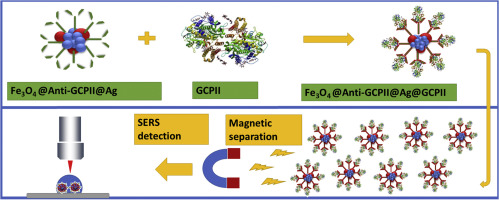当前位置:
X-MOL 学术
›
Anal. Chim. Acta
›
论文详情
Our official English website, www.x-mol.net, welcomes your feedback! (Note: you will need to create a separate account there.)
Label-free determination of prostate specific membrane antigen in human whole blood at nanomolar levels by magnetically assisted surface enhanced Raman spectroscopy
Analytica Chimica Acta ( IF 6.2 ) Pub Date : 2018-01-01 , DOI: 10.1016/j.aca.2017.10.008 Zuzana Chaloupková , Anna Balzerová , Jitka Bařinková , Zdenka Medříková , Pavel Šácha , Petr Beneš , Václav Ranc , Jan Konvalinka , Radek Zbořil
Analytica Chimica Acta ( IF 6.2 ) Pub Date : 2018-01-01 , DOI: 10.1016/j.aca.2017.10.008 Zuzana Chaloupková , Anna Balzerová , Jitka Bařinková , Zdenka Medříková , Pavel Šácha , Petr Beneš , Václav Ranc , Jan Konvalinka , Radek Zbořil

|
Prostate cancer is one of the most common cancers among men and can in its later stages cause serious medical problems. Due to the limited suitability of current diagnostic biochemical markers, new biomarkers for the detection of prostate cancer are highly sought after. An ideal biomarker should serve as a reliable prognostic marker, be applicable for early diagnosis, and be applicable for monitoring of therapeutic response. One potential candidate is glutamate carboxypeptidase II (GCPII), also known as prostate specific membrane antigen (PSMA), which has a promising role for direct imaging. GCPII is considerably over-expressed on cancerous prostatic epithelial cells; its analysis typically follows radiological or spectrophotometric principles. Its role as a biomarker present in blood has been recently investigated and potential correlation between a concentration of GCPII and prostate cancer has been proposed. The wider inclusion of GCPII detection in clinical praxis limits mainly the time and cost per analysis. Here, we present a novel analytical nanosensor applicable to quantification of GCPII in human whole blood consisted of Fe3O4@Ag magnetic nanocomposite surface-functionalized by an artificial antibody (low-molecular-weight GCPII synthetic inhibitor). The nanocomposite allows a simple magnetic isolation of GCPII using external magnetic force and its consecutive determination by magnetically assisted surface enhanced Raman spectroscopy (MA-SERS) with a limit of detection 6 pmol. L-1. This method enables a rapid determination of picomolar concentrations of GCPII in whole human blood of healthy individuals using a standard addition method without a complicated sample pre-treatment.
中文翻译:

磁辅助表面增强拉曼光谱法无标记测定人全血中纳摩尔水平的前列腺特异性膜抗原
前列腺癌是男性中最常见的癌症之一,在晚期会导致严重的医疗问题。由于当前诊断生化标志物的适用性有限,因此非常需要用于检测前列腺癌的新生物标志物。理想的生物标志物应作为可靠的预后标志物,适用于早期诊断,适用于监测治疗反应。一种潜在的候选物是谷氨酸羧肽酶 II (GCPII),也称为前列腺特异性膜抗原 (PSMA),它在直接成像方面具有广阔的应用前景。GCPII 在癌性前列腺上皮细胞上过度表达;其分析通常遵循放射学或分光光度学原理。最近研究了它作为血液中生物标志物的作用,并提出了 GCPII 浓度与前列腺癌之间的潜在相关性。在临床实践中更广泛地包含 GCPII 检测主要限制了每次分析的时间和成本。在这里,我们提出了一种适用于定量人全血中 GCPII 的新型分析纳米传感器,由人工抗体(低分子量 GCPII 合成抑制剂)表面功能化的 Fe3O4@Ag 磁性纳米复合材料组成。纳米复合材料允许使用外部磁力对 GCPII 进行简单的磁隔离,并通过磁辅助表面增强拉曼光谱 (MA-SERS) 进行连续测定,检测限为 6 pmol。L-1。
更新日期:2018-01-01
中文翻译:

磁辅助表面增强拉曼光谱法无标记测定人全血中纳摩尔水平的前列腺特异性膜抗原
前列腺癌是男性中最常见的癌症之一,在晚期会导致严重的医疗问题。由于当前诊断生化标志物的适用性有限,因此非常需要用于检测前列腺癌的新生物标志物。理想的生物标志物应作为可靠的预后标志物,适用于早期诊断,适用于监测治疗反应。一种潜在的候选物是谷氨酸羧肽酶 II (GCPII),也称为前列腺特异性膜抗原 (PSMA),它在直接成像方面具有广阔的应用前景。GCPII 在癌性前列腺上皮细胞上过度表达;其分析通常遵循放射学或分光光度学原理。最近研究了它作为血液中生物标志物的作用,并提出了 GCPII 浓度与前列腺癌之间的潜在相关性。在临床实践中更广泛地包含 GCPII 检测主要限制了每次分析的时间和成本。在这里,我们提出了一种适用于定量人全血中 GCPII 的新型分析纳米传感器,由人工抗体(低分子量 GCPII 合成抑制剂)表面功能化的 Fe3O4@Ag 磁性纳米复合材料组成。纳米复合材料允许使用外部磁力对 GCPII 进行简单的磁隔离,并通过磁辅助表面增强拉曼光谱 (MA-SERS) 进行连续测定,检测限为 6 pmol。L-1。



























 京公网安备 11010802027423号
京公网安备 11010802027423号